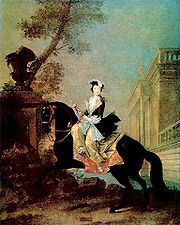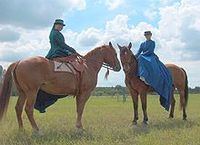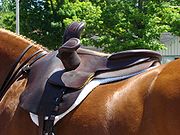Side-saddle Riding
This is part of the Articles series.
Written by Vix.
Note from the Author: Since side-saddle riding has been substantially replaced in the modern era by riding astride, many people know relatively little about it. However, since it was common back during the era of our game, I thought it might be useful to find out a little about it.
Side-saddle riding has been around since ancient times, and became popular in the Middle Ages in Europe as it allowed women to ride in a modest fashion while wearing fine clothing. There are images of women sitting aside on ancient Greek vases, although these were as passengers rather than in control of the horse. Back then, riding astride was the only way to have enough control over the horse to ride solo. The development of the side-saddle changed that, and remained popular until riding astride became socially acceptable in the early 20th century when women would wear split skirts, bloomers or eventually breeches for the activity.
Misconceptions
There are a number of misconceptions about side-saddle riding that I have heard over the years, mostly from simple lack of experience. I have it on good authority (my mother has ridden aside, and informs me that it is VERY comfortable and easy) that it is not the torturous tool of female oppression that it is sometimes portrayed as!
While cultural pressures did make the side-saddle necessary, it in fact developed out of a need for women of status to be able to control their own horses without having to bunch up their fashionable long skirts, which could be impractical and very awkward as well as unbecoming. For the majority of women, it was more an empowerment than otherwise.
There were some notable historical figures who did ride astride, such as Marie Antoinette and Catherine the Great (who even has a portrait of herself riding astride, dressed in a male officer's uniform), but I would have to assume that they would have had to wear trousers, and so they would have been the exceptions rather than the rule. Women riding astride would at the very least raise eyebrows, unless one was of sufficiently high status to be able to disregard this (e.g. Empress of all Russia...)

Contrary to popular belief, side-saddle riding is NOT:
- Uncomfortable, as long as the saddle is correctly fitted to the rider.
- Hard on the horse, as long as the saddle correctly fits the horse (and most saddles, especially when we are playing, would have been custom-made for the horse).
- Difficult to learn; most students can walk, trot and possibly even canter by the end of their first lesson.
- Limiting; saddle design has come a long way since the days of yore, and it is not uncommon for modern riders to gallop, jump, hunt and enter dressage contests riding aside. Regency riders would certainly have been able to canter, if not manage a risky gallop and possibly small jumps.
- Only for certain types of horse; there are very few that cannot take a side-saddle.
- Only for women; there are some men who ride aside, either for the challenge, for a display of some kind, or due to disability. Riding aside is perfect for people who have lost part of a leg.
- Archaic and no longer practiced; there are numerous side-saddle associations, teachers, and it remains a feature of dressage, eventing, show jumping, parades, historical re-enactment, and even specialist side-saddle exhibitions performed in period dress.

History of the side-saddle
One of the earliest designs is attributed to Anne of Bohemia, and is a chair-like design still seen in some epic films. The rider sat sideways, with her feet on a footrest. It was difficult for the rider to hold the reins and stay on the horse, so it was usually led, and the palfrey horse (with its smooth gait) became a popular mount for women.
Later, in the 16th century, a more practical design was available. We ladies have Catherine di Medici to thank for this one, where the rider sat facing forwards, with her leg hooked over the pommel and the addition of a stirrup for the lower foot. This now allowed women to control their own horse and ride at faster gaits.

In the 1830s (admittedly a little later than our game, sadly!), a double-pommel saddle was invented. The way this works is that the right leg goes around the top pommel, with the thigh lying across the horse's back and the lower leg down the horse's shoulder. The left leg then sits BELOW the lower pommel, with the foot in the stirrup, with the pommel therefore keeping the rider securely on the saddle. This allowed more freedom of movement, including gallops and jumping. The record for side-saddle jumping is 6ft 6 inches, set in Sydney in 1915. This development of the second pommel, also called a leaping horn, was the last major innovation in side-saddle design. This design is still used today.
Equipment
Aside from the saddle itself, a breastcollar is usually used to keep the saddle more steady, or sometimes a crupper (but rarely). There are no real differences in the bridles for side-saddle riding, although the reins need to be a little longer due to the position the rider must hold them.
A riding crop or whip are required, but for cueing purposes only - where an astride rider would use their right leg to give the horse a direction, a side-saddle rider does not have this option (since their leg is over the horse's back). The crop is used to replace this.

Because some saddles force the rider to hold the reins higher than usual, snaffle bits can cause the horse to have to raise its head too high, and so pelhams or double bridles may be used instead.
Riding
Posture is really important. The rider must sit squarely and centred on the horse, with both hips and shoulders square. A side-saddle rider should NOT be distinguishable from an astride rider when viewed from behind. Good balance and coordination are necessary to help keep your seat; good posture is also necessary to help ensure the horse's comfort and your own.